Podcast
Questions and Answers
What is the key difference in the concentration of proteins between plasma and interstitial fluid?
What is the key difference in the concentration of proteins between plasma and interstitial fluid?
- Plasma has a higher concentration of proteins than interstitial fluid. (correct)
- Both plasma and interstitial fluid have the same protein concentration.
- Plasma proteins are positively charged.
- Interstitial fluid has more proteins than plasma.
Which cations are primarily found in high concentrations within plasma?
Which cations are primarily found in high concentrations within plasma?
- K⁺ and Ca²⁺
- Na⁺ and Cl⁻
- Mg²⁺ and PO₄³⁻
- Na⁺ and K⁺ (correct)
What is the primary ionic composition difference between intracellular fluid (ICF) and plasma?
What is the primary ionic composition difference between intracellular fluid (ICF) and plasma?
- ICF contains more Na⁺ than plasma.
- ICF contains more Cl⁻ than plasma.
- ICF has larger amounts of K⁺ and PO₄³⁻ compared to plasma. (correct)
- Plasma contains more K⁺ than ICF.
Why do negatively charged ions tend to have a higher concentration in interstitial fluid compared to plasma?
Why do negatively charged ions tend to have a higher concentration in interstitial fluid compared to plasma?
Which ions are present in large quantities in extracellular fluid?
Which ions are present in large quantities in extracellular fluid?
Study Notes
Cations
- Plasma contains more protein than interstitial fluid.
- Proteins are negatively charged and attract cations, such as Na⁺ and K⁺ ions.
- Anions have a slightly higher concentration in the interstitial fluid due to repulsion by negatively charged plasma proteins.
- Extracellular fluid is rich in Na⁺, Cl⁻, HCO₃⁻ ions, but low in K⁺, Mg²⁺, Ca²⁺, PO₄³⁻, and organic acids.
Ionic Composition of ICF
- Intracellular fluid has low Na⁺ and Cl⁻, practically no Ca²⁺.
- Rich in K⁺ and PO₄³⁻, with moderate Mg²⁺ & SO₄²⁻.
- ICF has higher protein content than plasma.
Body fluid compartments
- Average young adult male:
- Protein and related substances: 18% of body weight
- Fat: 15% of body weight
- Minerals: 7% of body weight
- Water: 60% of body weight
- Percentage of Water in Tissues:
- Infant: 80%
- Male adult: 60%
- Female adult: 40-50%
- Old age: 45%
- Body fluid distribution:
- Extracellular fluid (ECF):
- Interstitial fluid (3/4 of ECF)
- Plasma (1/4 of ECF)
- Intracellular fluid (ICF): Separate compartment
- Transcellular fluid: Small volume
- Extracellular fluid (ECF):
- Continuous exchange: ECF and ICF exchange substances through capillary membranes.
Body Fluid Volumes
- Total Body Water (TBW): 0.6 x Body weight
- 70kg man:
- TBW: 42 liters
- ECF: 14 liters
- ICF: 28 liters
- Interstitial Fluid: 10.5 liters
- Plasma: 3 liters
- Transcellular Fluid: 0.5 liter
Observations
- Blood separates into 3 layers after centrifugation.
- Upper layer: Clear plasma
- Middle layer: Greyish white, thin, buffy layer
- Contains: Platelets (top) and WBCs (bottom)
- Bottom layer: Thick, packed RBCs
Results
- Hematocrit (H.V.) is the percentage of packed red cell volume to total blood volume: H.V.= Height of Packed red cell / Height of blood column X 100
Normal Values
- Male: 42-52%, RBCs: 2
- Female: 37-47%, RBCs: 7
- Infants: 53-55%
Causes of Increased H.V.
- Polycythemia: Excessive RBC production
- Dehydration: Reduced plasma, increased RBC concentration
Causes of Decreased H.V.
- Anemia: Reduced RBC count
- Overhydration: Increased plasma dilutes RBCs
Significance of H.V.
- Diagnosis: Anemia or polycythemia
- Measurement: Mean corpuscular volume (MCV)
- Blood volume determination
Questions
- Hematocrit: Percentage of packed red blood cells in total blood volume.
- High H.V.: Indicates high RBC concentration, possibly due to polycythemia or dehydration.
- Buffy coat: Thin, middle layer of blood containing platelets and white blood cells.
Studying That Suits You
Use AI to generate personalized quizzes and flashcards to suit your learning preferences.
Description
This quiz covers the composition and distribution of body fluids, focusing on cations in plasma and intracellular fluid. Explore the differences in ion concentrations and body composition across various age groups and genders. Test your knowledge on the significant roles of proteins and minerals in these fluids.




